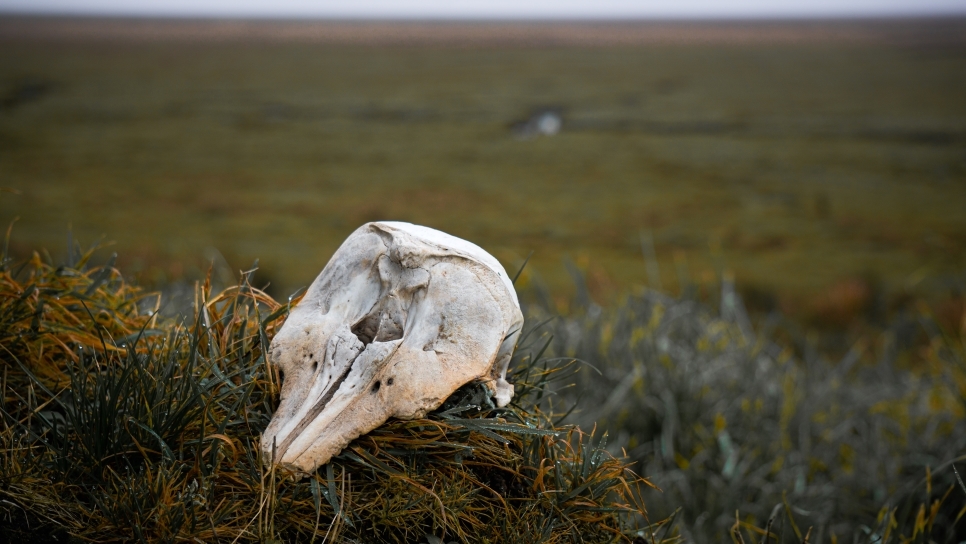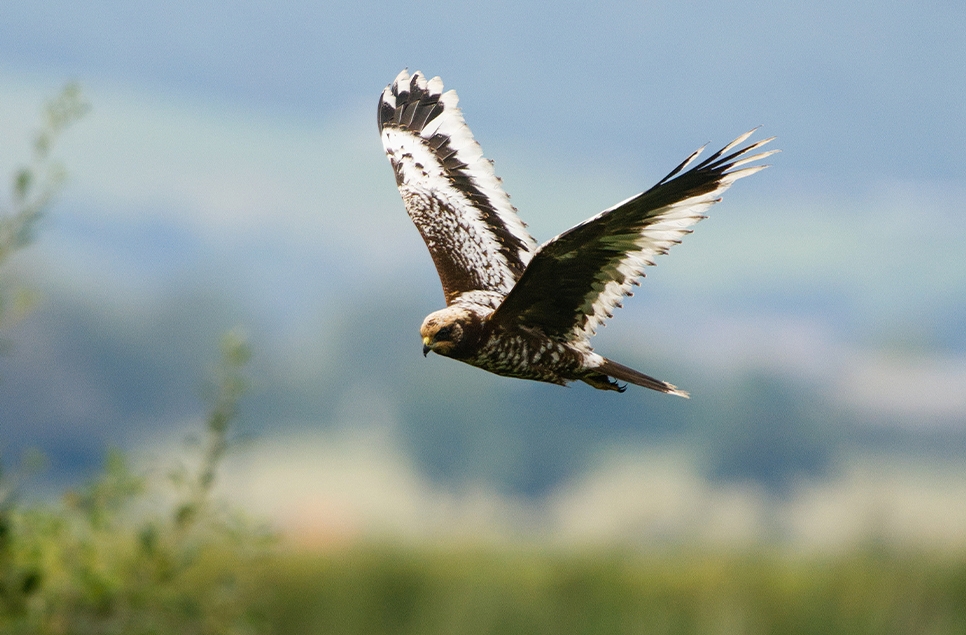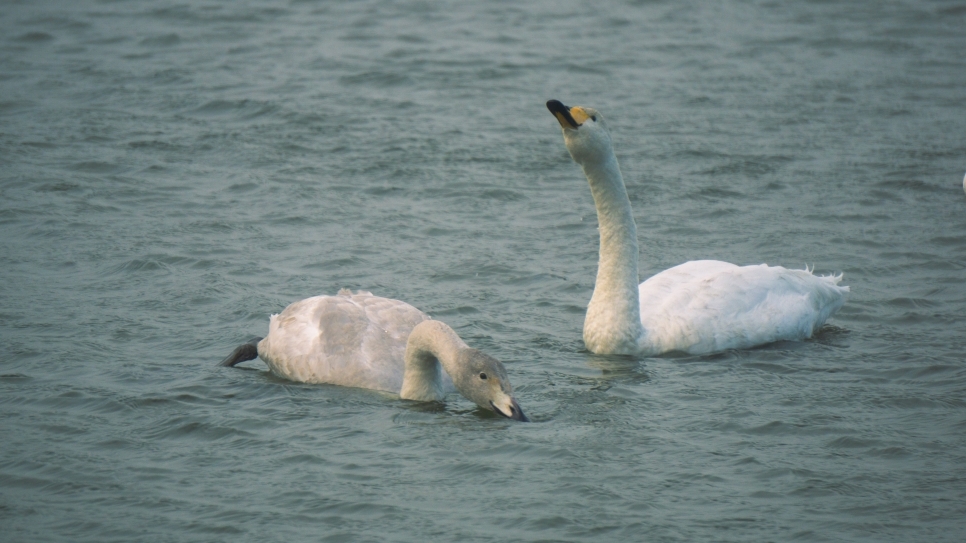Peregrines at Caerlaverock
Learn about these fantastic birds seen regularly on the reserve at Caerlaverock
Autumn brings an influx of waterbirds on the reserve and the merse and this attracts birds of prey, one of the most iconic of these is the peregrine falcon (Falco peregrinus), the UK’s largest falcon.
The Saltcot Observatory is a fantastic place to look out for peregrine falcons, which are often seen perching on fence posts out on the merse. They are also seen flying over the merse and they predate on the smaller waterbirds which flock to the reserve in winter in their thousands.
Peregrines are formidable hunters; they hunt from above then stoop down for their prey striking them in mid-air with their outstretched talons. Primarily feeding on smaller birds, the increased numbers of waterbirds make them easy pickings. Other prey consists of small mammals and amphibians.
Previous peregrine populations suffered from persecution and pesticide poisoning in the early 20th century and it is only over the last two decades that numbers have recovered and now see a large distribution across the UK. They live on all continents except Antarctica, current global population is estimated to c. 140,000 individuals, European population is estimated at 29,700-57,600 mature individuals (Birdlife International 2015). The British Trust for Ornithology (BTO) estimates the UK population in 2014 was 1,505 breeding pairs, and a nation survey in 2002 recorded 544 breeding pairs in Scotland.
The wandering bird. Peregrinus in Latin means ‘wanderer’ or ‘pilgrim’, though some individuals are resident many do migrate, and can travel up to 15,500 miles per year between nesting and wintering sites. Some nesting sites have been in continuous use for hundreds of years and occupied by further generations.
Notably the fastest animal on the planet! These speedy birds in travelling flight can reach an average speed of 25-34 mph which dramatically increases up to 69 mph when pursuing unsuspecting prey, this is just one of the reasons the Peregrine falcon is a firm favourite with bird watchers and have been used for falconry for over 4,000 years.
It’s a risky life being the fastest bird in the world. Their spectacular stoops and fast chases are a delight to witness, when stooping for prey peregrines can reach speeds of over 200 mph, an American research team clocked Frightful, one of their female study birds, at 242 mph while in a stoop. Traveling at these high speeds while in a stoop is dangerous, less than half of the young peregrines make it to adulthood. Life expectancy of an adult is approximately 6-12 years. In cities peregrines have less danger from being predated but increased risks of flying into a window of a building.
Adapted to live life in the fast lane. Peregrines can withstand 3 times more G-force than a fighter pilot and are great contortionists. To achieve high speeds, they shift their body shape through the air, by becoming a sleek teardrop shape with stiff compact wing feathers allows them to become hyper streamlined with little wind resistance they then dive vertically or at an angle entering a hyper dive and rocket towards their prey.
All falcons have a tubercle in their nostrils, this structure acts as a baffle causing rushing air to curve in a spiral motion as it enters the nostrils, this reduces air pressure within the nostrils which prevents lung damage.
The semi-transparent nictitating membrane or “third eyelid” closes sideways across the inner corner to the outer corner of the eye, and when the bird blinks this membrane lubricates and cleans the eye. This membrane can be closed which protects the eyes from dust particles and rushing air as the peregrine dives towards its prey. The tears of a peregrine are said to be as thick as golden syrup, and this prevents their eyes from drying out.
Inner morphological traits of this speed machine. Besides the physical features the peregrine’s internal organs and skeleton also contributes to their speed. The size of their keel bone, a ridge on the sternum, provides an anchor to which the major flight muscles are attached, and it is these muscles which the stiff feathered pointed wings are fastened. Falcons also have an extra pair of vertebrae on their tailbone, which ultimately improves manoeuvrability in their tail.
With a heart rate of 900 beats per minute (bpm), (average heart rate for a human is between 60 and 100 bpm), the increased bpm allows oxygen to travel throughout the peregrines body at a high rate which prevents them from becoming fatigued and allows the bird to flap their wings up to 4 times per second.
Sexual dimorphism and the division of labour. As with many other raptors, female peregrines are 50% heavier than males. This is thought to allow breeding pairs to exploit a wider range of prey through a division of labour: the male being able to catch more manoeuvrable prey; and the female capable of carrying up to 50% greater loads than the male. With all these remarkable adaptations, body shape and feather structure it is believed that an adult’s success rate in a hunt is 20%, this compares to 10% for sparrowhawks (Accipiter nisus), and 30% for hen harriers (Circus cyaneus).
Peregrine falcon fun facts.
- Average size in length 40-54cm
- Wingspan of 1 meter
- Weight 670g – 1.2kg
- In North America the peregrine is known as the ‘duck hawk’ or the ‘bullet hawk’
- Scientists designing the first jet engines used the peregrine’s nostril as a model
- Peregrines are believed to have binocular vision, 8 times better than our own
- Studies showed that peregrines sees more clearly when its head is turned at a 40-degree angle
- Courtship involves a display of dynamic aerial acrobatics
- Breeding pairs tend to be monogamous and mate for life
- Peregrines do not build nests, they find a shallow dip in the rocks or scape a depression in the soil on a cliff edge, or use a ledge of a building
- Can lay up to 5 eggs which are incubated mainly by the female for 29-33 days
- The chicks have disproportionately large feet compared to their body size, will fledge 42-46 days after hatching. Remain dependent on their parents for 2 months
- During WWII they become a target and were killed to protect homing pigeons
- Peregrines are a Schedule 1 listed species of The Wildlife and Countryside Act.


